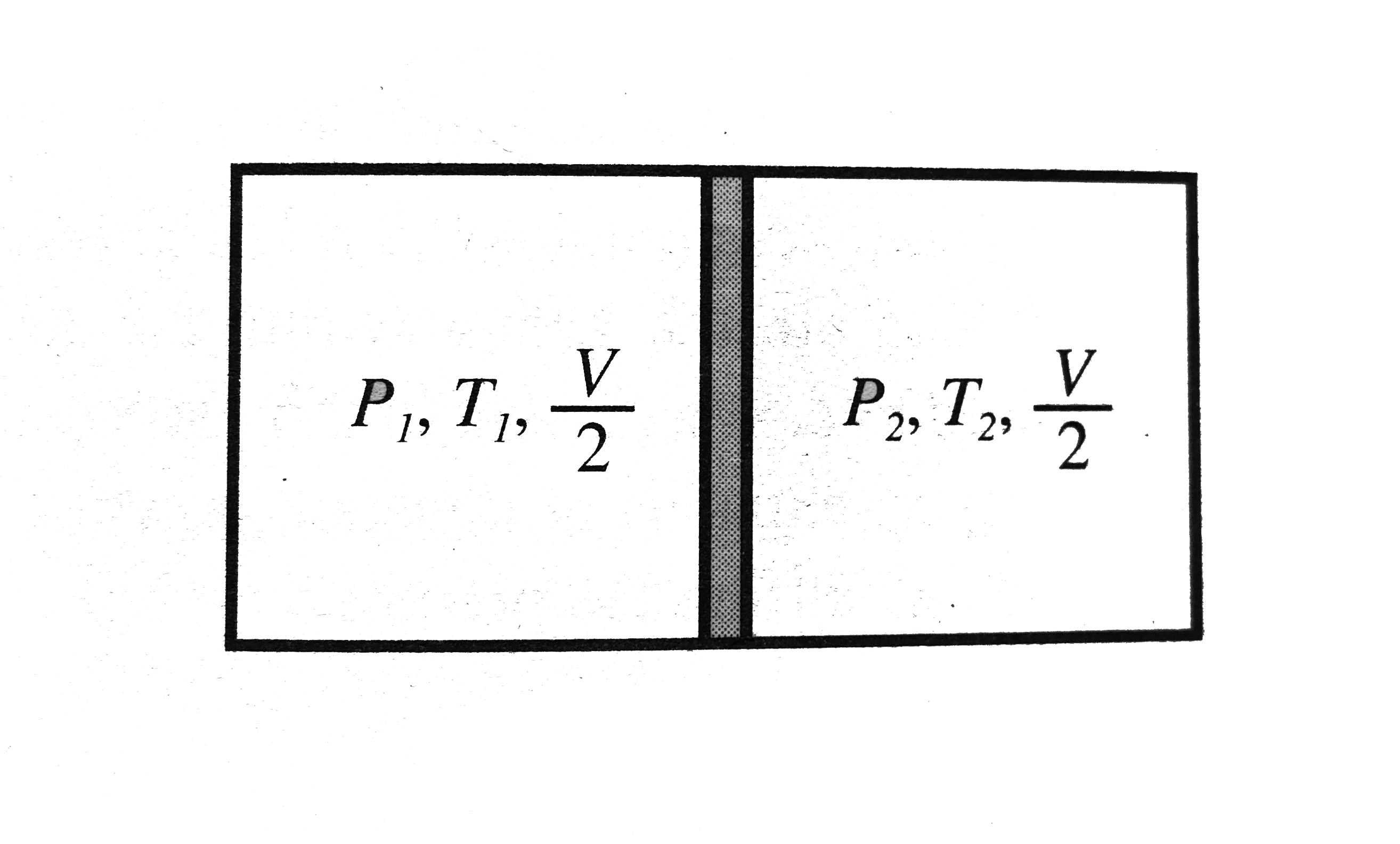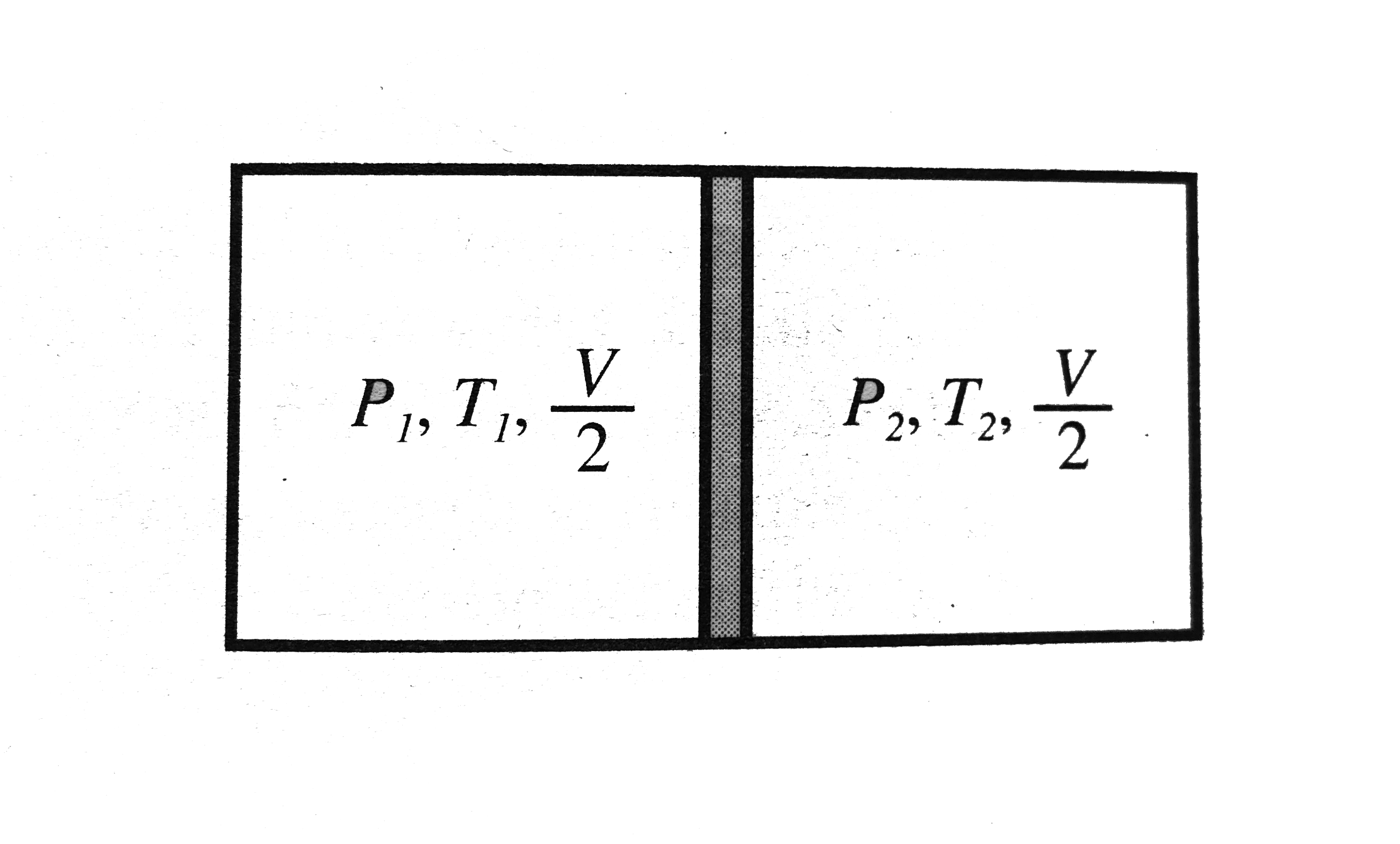A vertical thermally insulated cylinder of volume V contain n moles of an ideal monoatomic gas under a weightless piston. A load of weight W is placed on the piston as a result of which the piston is displaced. If the initial temp of the gas is 300K, area of piston is A and atmospheric pressure P0. (take W=P0A). Determine the value of final temperature of the gas
375K
425K
475K
515K
The correct Answer is:A
To determine the final temperature of the gas in the given scenario, we will follow these steps:
Step 1: Understand the System
We have a vertical thermally insulated cylinder containing n moles of an ideal monoatomic gas under a weightless piston. A load of weight W is placed on the piston, causing it to displace. The initial temperature of the gas is Ti=300K.
Step 2: Apply the First Law of Thermodynamics
Since the cylinder is thermally insulated, there is no heat exchange with the surroundings, which means:
\( Q = 0 \)
According to the first law of thermodynamics:
\( \Delta U = Q - W \)
Thus, we have:
\( \Delta U = -W \)
Where \( \Delta U \) is the change in internal energy and \( W \) is the work done on the system.
Step 3: Calculate the Change in Internal Energy
For a monoatomic ideal gas, the change in internal energy can be expressed as:
\( \Delta U = \frac{3}{2} n R (T_f - T_i) \)
Where \( T_f \) is the final temperature and \( T_i \) is the initial temperature.
Step 4: Determine the Work Done
The work done on the gas when the piston is displaced can be expressed as:
\( W = P_{0} A x + \frac{W}{A} A x = (P_{0} + \frac{W}{A})Ax \)
Where \( P_{0} \) is the atmospheric pressure, \( A \) is the area of the piston, and \( x \) is the displacement of the piston.
Step 5: Set Up the Equation
From the first law of thermodynamics, we can equate the change in internal energy to the work done:
\( \frac{3}{2} n R (T_f - T_i) = W \)
Substituting \( W \) from the previous step, we have:
\( \frac{3}{2} n R (T_f - T_i) = (P_{0} + \frac{W}{A})Ax \)
Step 6: Solve for Final Temperature
Rearranging the equation gives:
\( T_f - T_i = \frac{2}{3nR} W \)
Substituting \( T_i = 300 K \):
\( T_f = T_i + \frac{2}{3nR} W \)
Step 7: Substitute Values
Given that \( W = P_{0} A \):
\( T_f = 300 + \frac{2}{3nR} P_{0} A \)
Step 8: Final Calculation
To find the final temperature \( T_f \), we need to express \( W \) in terms of the initial conditions. Since \( W = P_{0} A \) and we know \( P_{0} \) and \( A \), we can calculate \( T_f \).
Assuming \( P_{0} = 1 \text{ atm} = 101325 \text{ Pa} \) and substituting values for \( n \) and \( R \) (where \( R = 8.314 \text{ J/(mol K)} \)):
\( T_f = 300 + \frac{2}{3n \times 8.314} \times 101325 \)
Step 9: Final Result
After performing the calculations, we find:
\( T_f = 375 K \)
Thus, the final temperature of the gas is:
\( \boxed{375 \text{ K}} \)
We have a vertical thermally insulated cylinder containing n moles of an ideal monoatomic gas under a weightless piston. A load of weight W is placed on the piston, causing it to displace. The initial temperature of the gas is Ti=300K.
Since the cylinder is thermally insulated, there is no heat exchange with the surroundings, which means:
\( Q = 0 \)
According to the first law of thermodynamics:
\( \Delta U = Q - W \)
Thus, we have:
\( \Delta U = -W \)
Where \( \Delta U \) is the change in internal energy and \( W \) is the work done on the system.
For a monoatomic ideal gas, the change in internal energy can be expressed as:
\( \Delta U = \frac{3}{2} n R (T_f - T_i) \)
Where \( T_f \) is the final temperature and \( T_i \) is the initial temperature.
The work done on the gas when the piston is displaced can be expressed as:
\( W = P_{0} A x + \frac{W}{A} A x = (P_{0} + \frac{W}{A})Ax \)
Where \( P_{0} \) is the atmospheric pressure, \( A \) is the area of the piston, and \( x \) is the displacement of the piston.
From the first law of thermodynamics, we can equate the change in internal energy to the work done:
\( \frac{3}{2} n R (T_f - T_i) = W \)
Substituting \( W \) from the previous step, we have:
\( \frac{3}{2} n R (T_f - T_i) = (P_{0} + \frac{W}{A})Ax \)
Rearranging the equation gives:
\( T_f - T_i = \frac{2}{3nR} W \)
Substituting \( T_i = 300 K \):
\( T_f = T_i + \frac{2}{3nR} W \)
Given that \( W = P_{0} A \):
\( T_f = 300 + \frac{2}{3nR} P_{0} A \)
To find the final temperature \( T_f \), we need to express \( W \) in terms of the initial conditions. Since \( W = P_{0} A \) and we know \( P_{0} \) and \( A \), we can calculate \( T_f \).
\( T_f = 300 + \frac{2}{3n \times 8.314} \times 101325 \)
After performing the calculations, we find:
\( T_f = 375 K \)
\( \boxed{375 \text{ K}} \)
Similar Questions
Two cylinders A and B fitted with pistons contain equal amounts of an ideal diatomic gas at 300K. The piston of A is free to move, while that B is held fixed. The same amount of heat is given to the gas in each cylinder. If the rise in temperature of the gas in A is 30K, then the rise in temperature of the gas in B is
View SolutionTwo cylinders A and B fitted with pistons contain equal amounts of an ideal diatomic gas at 300K. The piston of A is free to move, while that B is held fixed. The same amount of heat is given to the gas in each cylinder. If the rise in temperature of the gas in A is 30K, then the rise in temperature of the gas in B is
View Solution
Knowledge Check
- Question 1 - Select One
A heat insulating cylinder with a movable piston contins 5 moles of hydrogen at standard temperature and prssure if the gas is cmpressed to quarter of its original volume then the pressure of the gas is increased by (γ=1.4)
A(2)1.4B(3)1.4C(4)1.4D(5)1.4
A vertical cylinder of cross-section area A contains one mole of an ideal mono-atomic gas under a piston of mass M At a certain instant a heater which supplies heat at the rate q J/s is switched ON under the piston. The velocity with which the piston moves upward under the condition that pressure of gas remains constant is [Assume on heat transfer through walls of cylinder]
 View Solution
View SolutionA weightless piston divides a thermally insulated cylinder into two parts of volumes V and 3V.2 moles of an ideal gas at pressure P=2 atmosphere are confined to the part with volume V=1 litre. The remainder of the cylinder is evacuated. The piston is now released and the gas expands to fill the entire space of the cylinder. The piston is then pressed back to the initial position. Find the increase of internal energy in the process and final temperature of the gas. The ratio of the specific heats of the gas, γ=1.5.
View SolutionFigure shows an insulated cylinder of volume V containing monatomic gas in both the compartments. The pistone is diathermic. Initially the piston is kept fixed and the system is allowed to acquire a state of thermal equilibrium. The initial pressures and temperatures are as shown in the figure. Calculate

Final volume of the left compartment.View SolutionFigure shows an insulated cylinder of volume V containing monatomic gas in both the compartments. The pistone is diathermic. Initially the piston is kept fixed and the system is allowed to acquire a state of thermal equilibrium. The initial pressures and temperatures are as shown in the figure. Calculate

The final temperatureView SolutionFigure shows an insulated cylinder of volume V containing monatomic gas in both the compartments. The pistone is diathermic. Initially the piston is kept fixed and the system is allowed to acquire a state of thermal equilibrium. The initial pressures and temperatures are as shown in the figure. Calculate

The final presssures of left and right compartment respectively areView SolutionTwo moles of an ideal gas are contained in a vertical cylinder with a frictionless piston. The piston is slowly displaced so that expansionin gas is isothermal at temperature T0=400K. find the amount of work done in increasing the volume to 3 times.t ake atmospheric pressure =105N/m2
View Solution
A cylindrical tube of uniform cross-sectional area A is fitted with two air tight frictionless pistons. The pistons are connected to each other by a metallic wire. Initially the pressure of the gas is P0 and temperature is T0, atmospheric pressure is also P0. Now the temperature of the gas is increased to 2T0, the tension in the wire will beView Solution
